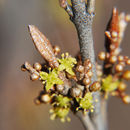More info for the term:
treeRusset buffaloberry is generally found on sandy, gravelly, or rocky
soils, and is able to thrive on nutrient-poor soils due to its
nitrogen-fixing ability [
5,
57]. Nodulation is variable and appears to
be most abundant in nutrient-poor, sandy soils [
37,
57]. Russet
buffaloberry grows on shores, riverbanks, dry slopes, moist north
slopes, open rocky woods, and occasionally in calcareous marshes [
50].
It forms dense thickets along riparian zones and valley bottoms [
37].
In Alaska it is uncommon or locally common in openings and forests of
dry uplands and in aspen forests on old burns [
57]. It has been
reported dominating dry, rocky sites in the Mission and Rattlesnake
mountains of Montana [
37]. It also dominates the most xerophytic
communities in Banff and Jasper National Parks, Alberta [
29], the driest
sites for tree growth in interior Alaska [
57], and the drier situations
in the Black Hills of South Dakota [
21]. Other sources have described
it as mesophilic and occurring on moist north slopes [
3,
37].
Elevations have been reported from 4,950 to 5,250 feet (1,500-1,600 m)
in Alberta [
46] and 6,600 to 8,200 feet (2,012-2,499 m) in Idaho [
43].

